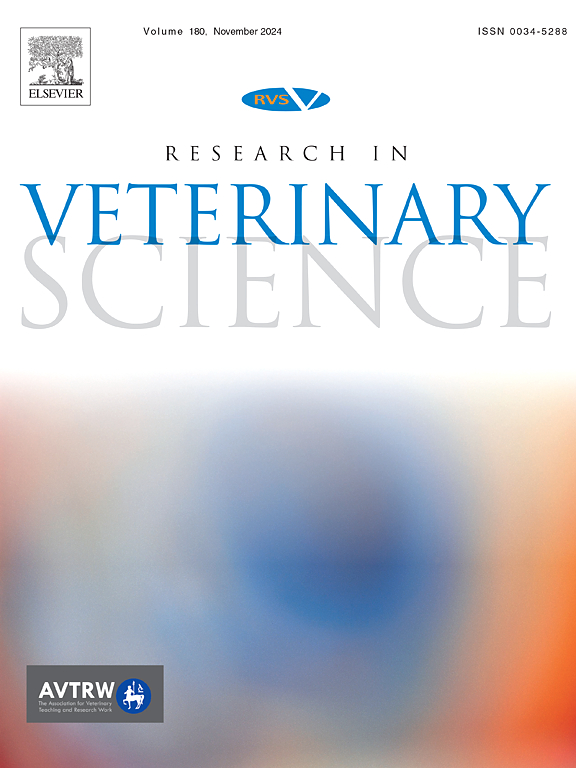ERα、HER-2、pan-RAS、p53和芳香化酶在犬自发性恶性乳腺肿瘤中的表达:与预后的相关性和与临床组织学参数的相关性
IF 2.2
3区 农林科学
Q1 VETERINARY SCIENCES
引用次数: 0
摘要
目的:在犬乳腺恶性肿瘤(mCMT)微环境中,原癌蛋白与肿瘤抑制蛋白之间的交错相互作用在很大程度上仍未被研究。本研究旨在解释i)肿瘤内ERα、HER-2、pan-RAS、p53和芳香化酶表达之间的关系,ii)它们与临床组织学参数和血清性激素的关系,以及iii)它们与mCMT预后的相关性。材料和方法:对27例mCMT动物肿瘤标本进行组织病理学和免疫组化检测,检测ERα、HER-2、pan-RAS、p53和芳香化酶。采用化学发光免疫分析法对mCMT犬和健康犬(n = 10)血清雌二醇和黄体酮水平进行测定。采用Kaplan-Meier分析(log-rank检验)、单变量和多变量Cox回归、Mann-Whitney U检验进行统计分析。结果:芳香化酶、ERα、pan-RAS、p53、HER-2在mCMT患者中的表达分别为100%、88%、67%、12%和11%。mcmt患者的血清雌二醇和黄体酮明显高于健康犬。此外,在mCMT患者中检测到ERα表达与芳香化酶(基质成分)和HER2表达呈正相关。此外,瘤内芳香酶表达和p53过表达分别与肿瘤大小和血管生成相关。其他肿瘤标志物、血清类固醇激素与临床组织学参数无相关性。P53过表达与mCMT患者的低生存率相关。结论:芳香化酶过表达和p53过表达在mCMT中具有临床相关性,瘤内ERα表达与HER-2表达和基质成分产生芳香化酶呈正相关。本文章由计算机程序翻译,如有差异,请以英文原文为准。
ERα, HER-2, pan-RAS, p53, and aromatase expression in spontaneous malignant canine mammary tumors: Prognostic relevance and association with clinicohistological parameters
Aim
The interlacing interaction between proto-oncoproteins and tumor-suppressing proteins in malignant canine mammary tumors (mCMT) microenvironment remains largely unexplored. The present study intended to decipher the i) association between the intratumoral expression of ERα, HER-2, pan-RAS, p53 and aromatase, ii) their relationship with the clinicohistological parameters and serum sex hormones, and iii) their prognostic relevance in mCMT.
Materials and methods
Tumor samples from animals with mCMT (n = 27) were subjected to histopathology and immunohistochemistry for ERα, HER-2, pan-RAS, p53, and aromatase. Serum estradiol and progesterone levels from dogs with mCMT and healthy dogs (n = 10) were estimated using chemiluminescence immunoassay. Kaplan-Meier analysis (log-rank test), univariable and multivariable Cox regression, and Mann-Whitney U test were employed for statistical analysis.
Results
The expression of aromatase, ERα, pan-RAS, p53, and HER-2 were detected in 100 %, 88 %, 67 %, 12 % and 11 % of mCMT cases, respectively. Serum estradiol and progesterone were significantly higher in mCMT-affiliated patients than healthy dogs. Also, a positive association of ERα expression with aromatase (stromal component) and HER2 expression in mCMT patients was detected. Furthermore, intratumoral aromatase expression and p53 overexpression were correlated with tumor size and angiogenesis, respectively. No relationship was detected between other tumor markers, serum steroid hormones and clinicohistological parameters. P53 overexpression was associated with poor survival in mCMT patients.
Conclusion
Overexpression of aromatase and p53 overexpression has clinical relevance in mCMT, and an intratumoral ERα expression is positively associated with HER-2 expression and aromatase production by stromal components.
求助全文
通过发布文献求助,成功后即可免费获取论文全文。
去求助
来源期刊

Research in veterinary science
农林科学-兽医学
CiteScore
4.40
自引率
4.20%
发文量
312
审稿时长
75 days
期刊介绍:
Research in Veterinary Science is an International multi-disciplinary journal publishing original articles, reviews and short communications of a high scientific and ethical standard in all aspects of veterinary and biomedical research.
The primary aim of the journal is to inform veterinary and biomedical scientists of significant advances in veterinary and related research through prompt publication and dissemination. Secondly, the journal aims to provide a general multi-disciplinary forum for discussion and debate of news and issues concerning veterinary science. Thirdly, to promote the dissemination of knowledge to a broader range of professions, globally.
High quality papers on all species of animals are considered, particularly those considered to be of high scientific importance and originality, and with interdisciplinary interest. The journal encourages papers providing results that have clear implications for understanding disease pathogenesis and for the development of control measures or treatments, as well as those dealing with a comparative biomedical approach, which represents a substantial improvement to animal and human health.
Studies without a robust scientific hypothesis or that are preliminary, or of weak originality, as well as negative results, are not appropriate for the journal. Furthermore, observational approaches, case studies or field reports lacking an advancement in general knowledge do not fall within the scope of the journal.
 求助内容:
求助内容: 应助结果提醒方式:
应助结果提醒方式:


